What an April! LWR received 25 intakes in 30 days, and yes, it was slightly insane around here–and still is!
I’m happy to report that the last of the five young cottontails were released, slowly, one at a time as they chose to leave. Yeah, I could have hard-released them all out at once, but their little lives are already so short and stress-filled–why add to that? I like my option better.
One of our sad tales is an imprinted young adult barred owl who was found in the woods by a hunter. Some idiot had made a pet of her, then dumped her to fend for herself when she had no clue how to do so. Folks, this is why wildlife rehabbers are licensed: we know how to raise these animals without imprinting them, and we know how to prepare them to fend for themselves upon release. There’s just no excuse for anyone to keep a wild animal and try to make a pet of it; it won’t work. Legal issues aside, it ruins the animal’s life and poses a threat to the humans. At the risk of repeating myself, let me state once again, for the record: Wildlife is best enjoyed in its natural environment.
What happened to this poor baby? As you can see in the photo taken during her visit to Peggy Hobby at Smalley’s Animal Hospital, she was quite tame and would have probably required euthanasia, per federal guidelines for imprinted birds. As it is, because of a lousy diet in captivity, she had major health issues and a few days after she was transferred to Steve Hicks of Bubba & Friends, Steve reported that his emergency measures were useless against the multiple issues the bird had as a result of poor nutrition during her formative stages. She died, a victim of some human’s stupidity.
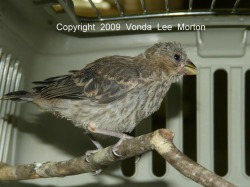
Songbird babies are also flooding in: the first was this little house finch, who has a minor beak deformity which shouldn’t interfere with his ability to eat seed, once he finally recognizes seed as food. Finches are notoriously slow to become independent.
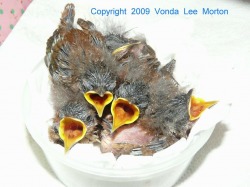
Then came a nest of five Carolina wrens–yes, the entire nestful! (If it’s not a word, it should be.) Long story short, a lady bought items in a box at a Bibb County store and when she got home and opened the box, there was a nest full of babies. Wrens are adorable, flighty, stressy little birds who will nest in your hair if you stand still for five minutes.
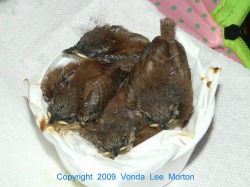
Two days later, another set of four Carolina wrens was found on the ground in a local parking lot. Nine screaming wrens! And believe me, wrens are the little masters of feathered histrionics!
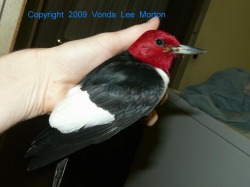
I also received an adult red-headed woodpecker with what appeared to be spinal injuries. He couldn’t fly and didn’t seem to be able to move his tail feathers. Upon examination, Peggy Hobby at Smalley’s agreed that his injuries were beyond repair and he was euthanized. I know some people might prefer not to know when an animal brought to LWR dies or is euthanized–it ruins the warm, fuzzy feeling–but it’s a national statistic that some 50% of animals brought into wildlife rehab will not survive. Better we put them down humanely after they come into rehab, however, than they suffer for days or weeks, slowly starving to death, being stung to death by fire ants or having vultures start snacking on them before they’re dead but after they’re too weak to defend themselves. Grossed out? Sorry; these are the facts of life, and rehabbers deal with them every single day.
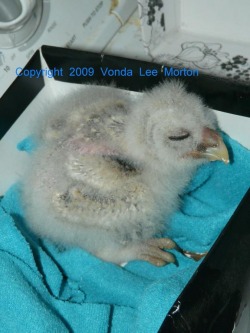
I also had a hatchling Great Horned Owl come in, with his egg tooth (used to break out of the egg) still intact–yep, he was that young. We struggled to keep him going, but he died yesterday, the day he was to be transferred to Steve Hicks. We still don’t know how a baby who couldn’t even hold his head up yet could have gotten out of the nest; one theory we’ve thrown around is that he was the last-hatched (owls lay their eggs one a week to stagger the hatching and subsequent care of the young) and that the parents were dealing with older sibs who’d already branched when a predator snagged this baby for a snack and then dropped him. It’s just a theory; we’ll never know for sure, but it does fit the few facts that we do know.
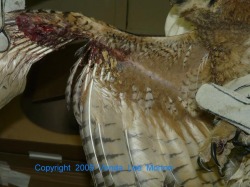
And while I was dealing with being massively bummed out over losing this baby, another Great Horned Owl, this one a juvenile, ended up at LWR. At first glance, his wing injury looked like cause for euthanasia, but once I got him settled down (as much as these bird “settle down”) and was able to look more closely, I realized the bone didn’t appear to be broken. There was a lot of damaged flesh and broken and missing feathers, not to mention the fly eggs layered on the wounds, but all this was treatable, I thought. I called Steve Hicks, described the damage and e-mailed him some photos for his opinion, and to my delight, he agreed that this should be a “fixable” injury. We just needed to clean the fly eggs off ASAP...yeah, right. Little Killer was gonna be reeaal happy about that...
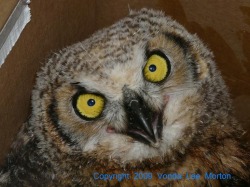
I needed help with this one–someone had to restrain the bird and someone had to clean eggs off. My niece and her friend tried to help but just couldn’t handle the maggots and eggs, so they ran home to get my sister Sharon, who held the unwilling patient while I cleaned...and cleaned...and cleaned. After an hour, we still didn’t have all the eggs off, but we had as many as we were gonna get for the night. We doused the wing heavily with antiseptic liquid and let the poor fellow rest for the night.
This morning, Little Killer made a trip to Smalley’s, where Jim Hobby took one look at the maggot-infested wound and instructed us to take him to the back of the clinic, where there was a large sink and a pressurized hose, and get the remaining parasites out. It took me and vet techs Sara and Jamie around 45 minutes of scrubbing and rinsing to get all the little creepy-crawlies off the poor baby’s wing. Well, technically, Jamie and Sara did all the hard work; I just restrained Little Killer so that no one lost digits or had to have owl talons surgically removed from their faces. I ask you, is the photo above the face of a happy camper?? I think not!
Once we were done, Jim gave our very unhappy patient an antibiotic injection and he’s now good to go for transfer. We’re all hoping for a full recovery, but he has a long, hard road ahead of him...and by the way, he hates us all now.
I leave you this update with a shot of the nine wrens and one finch all perching together in their carrier. Next week they go to the flight pen. Now, THAT should be fun...
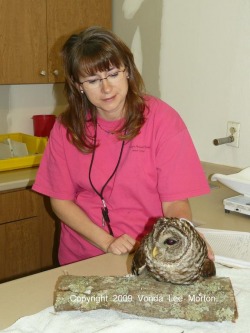
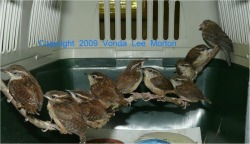
 RSS Feed
RSS Feed
